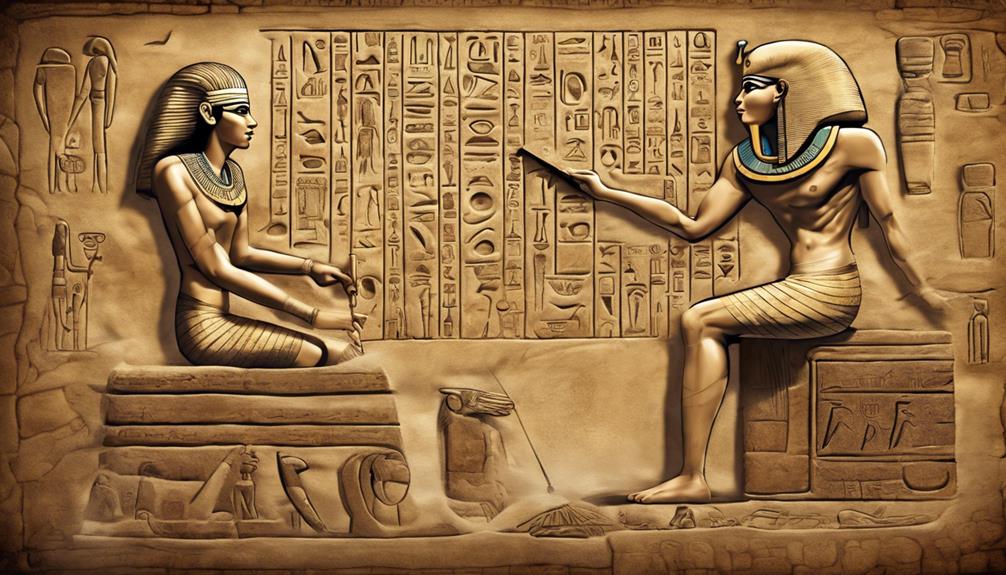The ancient Egyptians' writing system, primarily composed of hieroglyphs, offers a fascinating insight into their sophisticated communication methods. By combining phonetic glyphs, logographs, and determinatives, they created a dynamic script that captured sounds, meanings, and morphemes. The evolution of hieroglyphics, influenced by diverse traditions and ancient scripts, reveals a complex tapestry of cultural exchange. Understanding how these intricate symbols conveyed a language rich in nuances and symbolism opens a gateway to deciphering the mysteries of this ancient civilization's intellectual heritage.
Key Takeaways
- Hieroglyphics combined logographic and alphabetic elements for linguistic representation.
- Symbols in hieroglyphics conveyed sounds, meanings, and objects with diverse interpretations.
- Understanding grammar, context, and symbol nuances was crucial for deciphering hieroglyphs.
- Decipherment efforts by scholars like Champollion revolutionized the study of ancient Egyptian culture and history.
Origins of Ancient Egyptian Writing
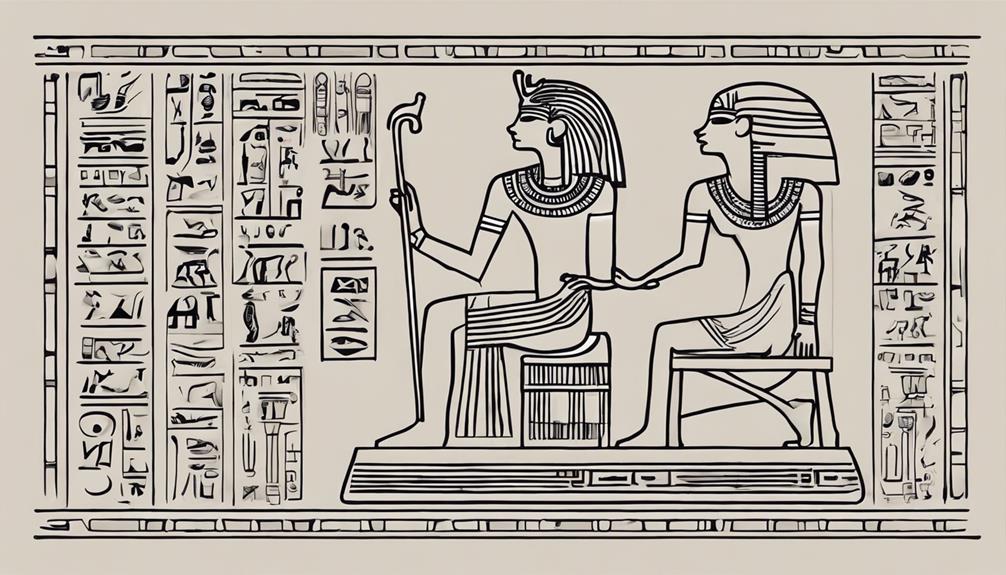
Around 3400 B.C., the origins of Ancient Egyptian writing, commonly referred to as hieroglyphics, can be traced back to the preliterate artistic traditions of Egypt. Hieroglyphs were the earliest form of Egyptian writing and played a crucial role in recording history, language, and culture. The Egyptian hieroglyphic system consisted of a combination of logographic and alphabetic elements, with intricate signs representing objects, sounds, or ideas. These signs could be written in various directions, including left to right, right to left, or top to bottom, adding to the complexity of the script.
The development of hieroglyphs was influenced by the Sumerian script but evolved independently in Egypt, showcasing the unique linguistic and artistic capabilities of the ancient Egyptians. The inclusion of phonetic complements in hieroglyphic writing allowed for a more comprehensive representation of the Egyptian language, enabling scribes to convey subtle nuances and meanings. This intricate fusion of signs, symbols, and phonetic elements laid the foundation for the rich history of Ancient Egyptian writing.
Development of Hieroglyphic Script
The evolution of the ancient Egyptian hieroglyphic script marked a significant advancement in the development of a complex writing system, characterized by approximately 500 common signs encompassing phonograms, ideograms, and determinatives for comprehensive linguistic representation. Hieroglyphs played a crucial role in ancient Egyptian culture, shaping their beliefs, history, and language development. The script featured phonetic signs representing sounds, logograms for tangible objects, and determinatives for semantic clarification. It was primarily employed for inscriptions on temples, tombs, and various surfaces for religious and administrative purposes.
- The intricate hieroglyphic script reflected the sophisticated nature of ancient Egyptian communication.
- Hieroglyphs provided a window into the cultural and religious practices of ancient Egypt.
- The use of determinatives added depth and clarity to the written language of the time.
- Hieroglyphs were essential for recording historical events and religious beliefs.
- The development of hieroglyphics showcases the intellectual prowess of ancient Egyptians in creating a comprehensive writing system.
Use of Hieroglyphics in Ancient Egypt
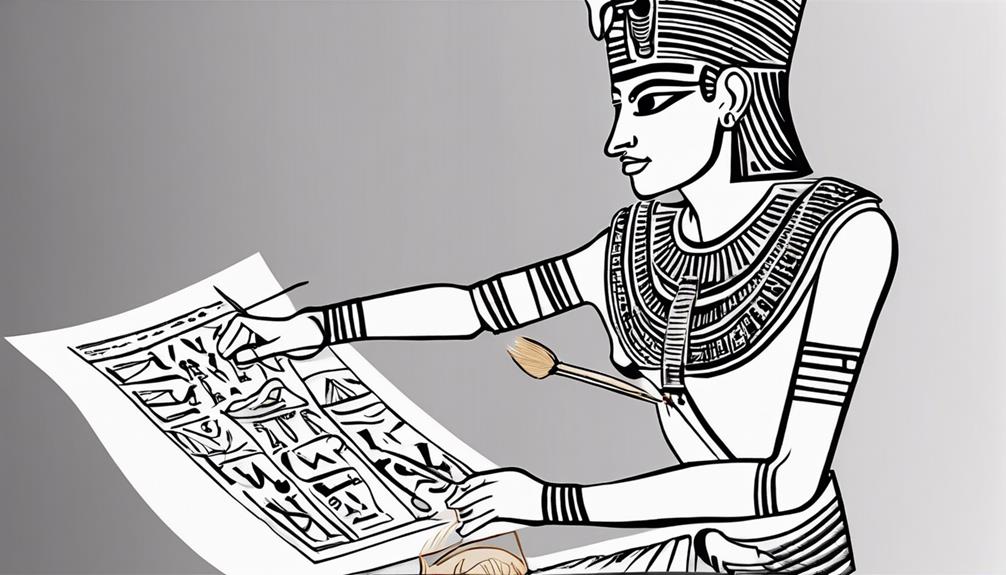
The intricate system of hieroglyphics in ancient Egypt played a pivotal role in transmitting and preserving cultural, religious, and historical information through a complex array of pictorial symbols. Ancient Egyptians used hieroglyphics extensively, employing around 500 common signs that combined ideograms representing tangible objects with phonograms used for spelling out words. This writing system, intertwined with the language spoken by ancient Egyptians, evolved over millennia through different phases like Old, Middle, Late, Demotic, and Coptic. Hieroglyphs were not merely decorative; they provided profound insights into ancient Egyptian beliefs, culture, and history, primarily serving religious or afterlife purposes. Inscriptions adorned temples, tombs, and various objects, underscoring the significance and widespread use of hieroglyphics in ancient Egyptian society.
| Egyptians | Hieroglyphic Writing | Hieroglyphs |
|---|---|---|
| Ancient Egypt | Writing System | Language |
| Symbols | Culture | Inscriptions |
Hieroglyphic Writing System Characteristics
Hieroglyphic writing in ancient Egypt encompassed a complex system of phonetic glyphs, logographs, and determinatives to convey sounds, meanings, and morphemes. These symbols were utilized for phonetic readings to represent the sounds of the Egyptian language, while logograms were employed to depict objects and common nouns. Additionally, hieroglyphs incorporated phonetic complements for pronunciation clarity and included grammatical signs for encoding flexional endings and linguistic features.
Symbolic Representation in Hieroglyphs
Symbolic representation in ancient Egyptian hieroglyphs encompasses a sophisticated system of symbols that convey sounds, concepts, and objects with diverse meanings and interpretations.
- Utilization of phonetic, logographic, and ideographic symbols
- Complex characters with specific linguistic functions
- Integration of art and language to convey cultural and historical information
- Hieroglyphs require understanding of grammar, context, and nuanced symbol usage
- Not purely pictorial but a structured system with rich linguistic capabilities
This amalgamation of symbols serves as a testament to the advanced nature of ancient Egyptian writing, blending artistic expression with functional communication to capture the essence of their culture and history.
Writing Tools and Materials
Ancient Egyptian hieroglyphic writing, characterized by its intricate symbolic representation, was facilitated by the utilization of specific writing tools and materials essential to the transmission of information and ideas. Reed brushes and ink made from carbon black or iron gall were commonly used to inscribe hieroglyphs on diverse surfaces like papyrus, limestone, and pottery. Skilled scribes were crucial for accurately depicting the complex symbols and meanings within elaborate hieroglyphic compositions. Additionally, materials such as ostraca, pottery, and papyrus provided versatile surfaces for hieroglyphic writing in various contexts. Wooden tablets and ostraca were also employed for everyday writing needs. The table below outlines some of the key writing tools and materials used in ancient Egyptian hieroglyphic writing.
| Writing Tools | Writing Materials |
|---|---|
| Reed Brushes | Papyrus |
| Ostraca | Limestone |
| Wooden Tablets | Pottery |
Challenges in Reading Hieroglyphics
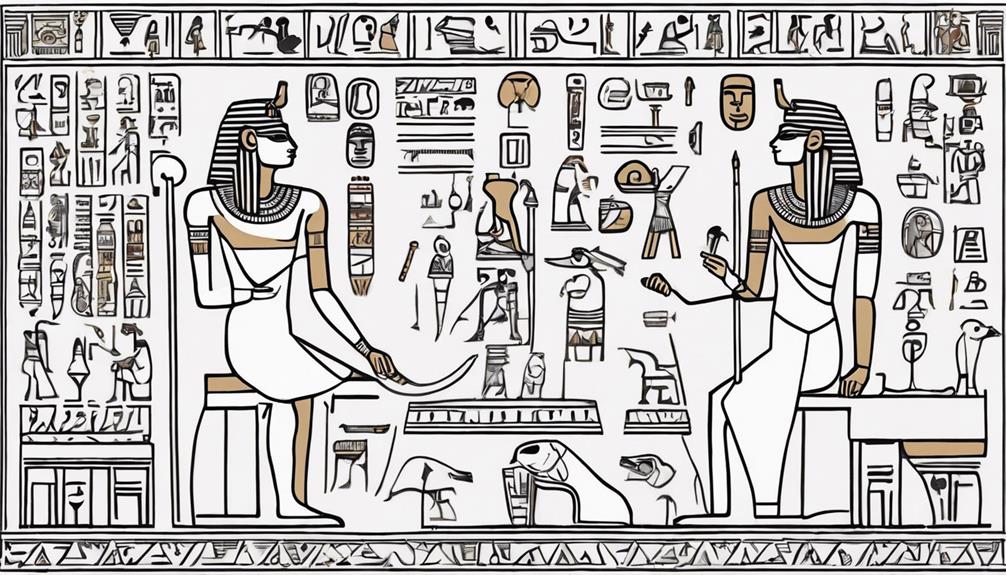
Deciphering ancient Egyptian hieroglyphics presents a formidable challenge due to the absence of vowel representation and the reliance on consonants. Understanding the symbolic meanings behind complex symbols and translating pictorial representations are crucial aspects in overcoming the hurdles of reading hieroglyphics. These challenges necessitate a meticulous approach that involves a deep grasp of linguistic nuances and grammatical structures to unlock the messages encoded within the ancient texts.
Deciphering Complex Symbols
Interpreting hieroglyphics poses a formidable challenge due to the intricate combination of phonetic, logographic, and determinative signs. Understanding hieroglyphs requires merging phonetic readings with symbolic meanings and grammar clues. Scholars rely on context, known vocabulary, and parallel texts to decode the diverse elements of hieroglyphic inscriptions. Pronunciation uncertainties and missing vowels in hieroglyphs further complicate the reading and translating of ancient Egyptian texts. Despite these obstacles, advancements in linguistics, comparative studies, and the decipherment of the Rosetta Stone have significantly enhanced our comprehension of hieroglyphic symbols.
- The complexity of hieroglyphic symbols can be overwhelming.
- Deciphering these ancient scripts requires patience and dedication.
- Each sign carries layers of meaning, adding to the challenge.
- Scholars constantly push the boundaries of linguistic understanding.
- The Rosetta Stone remains a pivotal key in unlocking the secrets of hieroglyphics.
Understanding Symbolic Meanings
Challenges in reading hieroglyphics stem from the intricate symbolic meanings embedded within the ancient script, requiring a nuanced understanding of cultural contexts and linguistic subtleties. Deciphering hieroglyphics involves recognizing phonetic, ideographic, and determinative elements within the symbols. To unlock the meanings accurately, scholars must blend linguistic expertise, historical knowledge, and visual analysis. Hieroglyphics present a complex system where symbols can represent sounds, concepts, or whole words. The interpretation of hieroglyphic symbols demands careful consideration of the visual and phonetic aspects of each symbol. This intricate process highlights the depth of knowledge and expertise necessary for accurately understanding the symbolic meanings conveyed through hieroglyphics. Success in deciphering these ancient scripts hinges on a holistic approach that combines linguistic prowess, historical acumen, and keen visual interpretation.
Translating Pictorial Representations
Translating pictorial representations in hieroglyphics poses a significant challenge due to the symbolic complexity inherent in the script. Ancient Egyptians used hieroglyphic signs to represent concepts, sounds, and objects, making it intricate to decipher. Hieroglyphics were written on papyrus and adorned temples and tombs. The use of determinatives added to the complexity, as these symbols clarified the meaning of the preceding words. Understanding hieroglyphics required knowledge of the spoken language, historical context, and cultural symbolism. Deciphering hieroglyphics demanded a combination of linguistic analysis and visual interpretation skills, highlighting the intricate nature of this ancient writing system.
Rosetta Stone and Hieroglyphic Decipherment
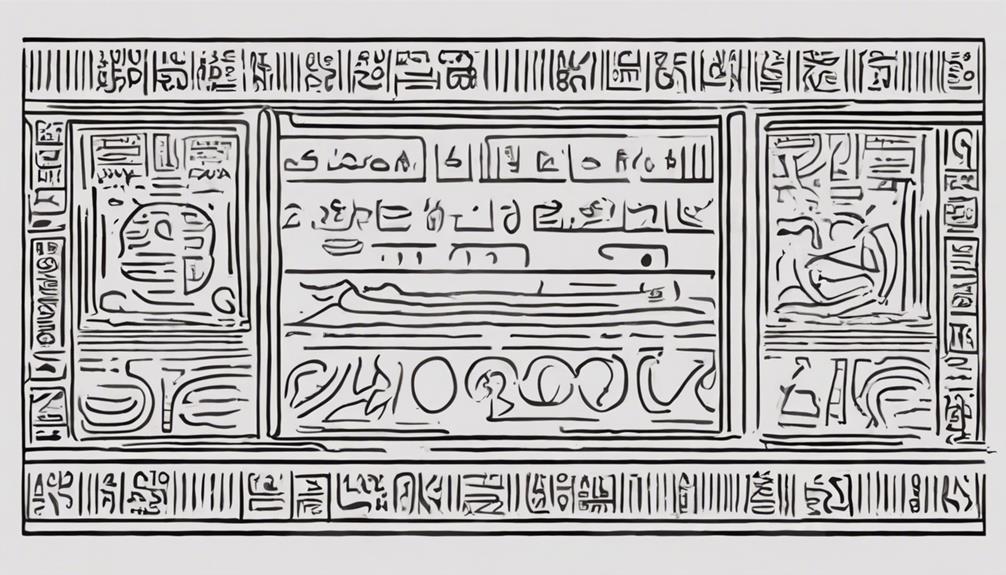
The Rosetta Stone, a significant archaeological artifact discovered in 1799, played a pivotal role in the decipherment of hieroglyphics by containing inscriptions in hieroglyphic, demotic, and ancient Greek. This discovery marked a turning point in understanding how hieroglyphics could be written and decoded. Thomas Young made progress by initially deciphering the phonetic spellings of royal names on the Rosetta Stone. However, it was Jean-Francois Champollion who made the breakthrough in deciphering Egyptian writing by combining phonetic and ideographic symbols. Champollion's deep knowledge of the ancient Egyptian language, along with the study of the Coptic language, which was a later form of Egyptian written in the Greek alphabet, were instrumental in unraveling the mysteries of hieroglyphics. The decipherment of hieroglyphics was a complex and intricate process that revolutionized the study of ancient Egyptian culture and history, shedding light on a civilization that had been enigmatic for centuries.
Legacy of Ancient Egyptian Writing
Ancient Egyptian writing, encompassing hieroglyphs, hieratic, and demotic scripts, has left a lasting legacy in the study of linguistic and cultural history. Hieroglyphs, with their combination of pictorial symbols, phonetic, and ideographic meanings, were the most intricate form of Egyptian writing. Hieratic script, a cursive version of hieroglyphs, was mainly utilized for administrative purposes due to its efficiency. The demotic script, which succeeded hieratic, became the prevalent script for everyday writings. Additionally, the Coptic script, derived from Greek, played a crucial role in preserving and understanding hieroglyphic knowledge during the Christian period in Egypt. The evolution of these scripts showcases the adaptability and sophistication of ancient Egyptian writing systems, offering valuable insights into the civilization's communication methods and administrative practices.
Modern Understanding of Hieroglyphics
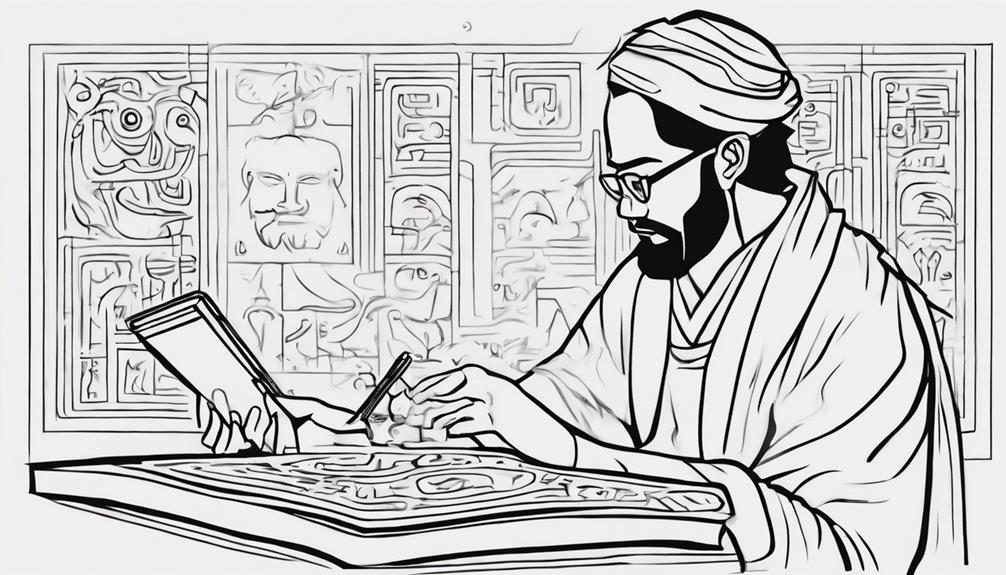
Hieroglyphics, essential to understanding ancient Egyptian communication, have been significantly elucidated through the decipherment efforts led by Champollion in the 1820s. Champollion's breakthrough in deciphering the hieroglyphic script unveiled a complex system comprising phonetic glyphs, logograms, and determinatives. Phonetic glyphs represent sounds, logograms depict words or concepts, and determinatives provide context to clarify meaning. Modern advancements in technology, such as Unicode support and specialized fonts like Aegyptus and Noto Sans Egyptian Hieroglyphs, have facilitated the digital representation of hieroglyphics, ensuring their preservation and dissemination.
Unicode support enables the inclusion of a wide range of hieroglyphic characters in digital texts, while specialized fonts cater specifically to the nuances of this ancient script. The inclusion of phonetic complements alongside hieroglyphic signs aids in pronunciation clarification and serves aesthetic purposes. Through the integration of modern technology, the knowledge of hieroglyphics continues to be preserved and shared, allowing for a deeper understanding of ancient Egyptian culture and communication.
Frequently Asked Questions
What Was the Egyptian Way of Writing?
The Egyptian way of writing encompassed a sophisticated system of hieroglyphic symbols, utilized on various mediums like papyrus scrolls and tomb inscriptions. Scribes employed specific tools to meticulously craft these symbols, representing both phonetic sounds and logographic meanings. The calligraphy style used in royal decrees and religious texts displayed a high level of artistic skill. Over time, scripts like hieratic were developed for practical use, eventually leading to the decipherment of hieroglyphs through the Rosetta Stone.
What Was the Writing System of Ancient Egypt?
The writing system of ancient Egypt was primarily based on hieroglyphic symbols, which were used on various surfaces like papyrus scrolls. These symbols included phonetic hieroglyphs that represented sounds and concepts. The decipherment of hieroglyphs was greatly aided by the Rosetta Stone, showcasing translations in multiple languages. Scribes employed specific techniques and writing tools to inscribe these symbols, with each symbol holding deep cultural and religious meanings. Hieratic script was a cursive version of hieroglyphs used for everyday writing on different materials.
How Did the Egyptian Civilization Write?
The Egyptian civilization utilized hieroglyphic symbols on papyrus scrolls, employing ink brushes and other writing tools. Scribes, a respected profession, were responsible for creating written records using a combination of phonetic alphabet and hieratic script. These scripts incorporated phonetic symbols to communicate language effectively. The intricate writing system of ancient Egypt reflected their advanced understanding of language and facilitated the preservation of their culture, history, and beliefs.
What Are the 3 Types of Ancient Egyptian Writing?
The three types of ancient Egyptian writing are hieroglyphic, hieratic, and demotic scripts. Hieroglyphic symbols were intricate and formal, used on monumental inscriptions and religious texts. Hieratic script, derived from hieroglyphs, was cursive and practical, serving administrative and daily purposes. Demotic script, a simplified version of hieroglyphs, was later used for various writings. Each script played specific roles in ancient Egyptian society, reflecting the evolution and adaptability of their writing systems.
Conclusion
In conclusion, the intricate hieroglyphic script of ancient Egyptians served as a remarkable form of linguistic representation, blending phonetic glyphs, logographs, and determinatives to convey sounds, morphemes, and meanings. Despite the challenges in deciphering this complex writing system, the discovery of the Rosetta Stone was a pivotal moment in unraveling the mysteries of hieroglyphics. Today, the legacy of ancient Egyptian writing continues to captivate scholars and enthusiasts alike, shedding light on the rich cultural heritage of this ancient civilization.
